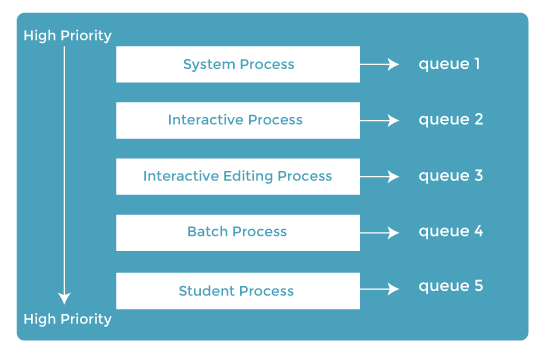Multilevel Queue Scheduling in Operating SystemIn this article, you will learn about multilevel queue scheduling and the several types of processes in the multilevel queue in the OS. Multilevel Queue SchedulingEach algorithm supports a different process, but in a general system, some processes require scheduling using a priority algorithm. While some processes want to stay in the system (interactive processes), others are background processes whose execution can be delayed. The number of ready queue algorithms between queues and within queues may differ between systems. A round-robin method with various time quantum is typically utilized for such maintenance. Several types of scheduling algorithms are designed for circumstances where the processes can be readily separated into groups. There are two sorts of processes that require different scheduling algorithms because they have varying response times and resource requirements. The foreground (interactive) and background processes (batch process) are distinguished. Background processes take priority over foreground processes. The ready queue has been partitioned into seven different queues using the multilevel queue scheduling technique. These processes are assigned to one queue based on their priority, such as memory size, process priority, or type. The method for scheduling each queue is different. Some queues are utilized for the foreground process, while others are used for the background process. The foreground queue may be scheduled using a round-robin method, and the background queue can be scheduled using an FCFS strategy. Advantages and Disadvantages of Multilevel Queue SchedulingThere are various advantages and disadvantages of multilevel queue scheduling. Some of the advantages and disadvantages of the multilevel queue scheduling are as follows: Advantages
Disadvantages
ExampleLet's take an example of a multilevel queue-scheduling algorithm with five queues to understand how this scheduling works: 
Every queue would have an absolute priority over the low-priority queues. No process may execute until the high-priority queues are empty. In the above instance, no other process may execute until and unless the queues for system, interactive, and editing processes are empty. If an interactive editing process enters the ready queue while a batch process is underway, the batch process will be preempted. There are the descriptions of the processes that are used in the above example: System Process The OS has its process to execute, which is referred to as the System Process. Interactive Process It is a process in which the same type of interaction should occur. Batch Process Batch processing is an operating system feature that collects programs and data into a batch before processing starts. Student Process The system process is always given the highest priority, whereas the student processes are always given the lowest. Example ProblemLet's take an example of a multilevel queue-scheduling (MQS) algorithm that shows how the multilevel queue scheduling work. Consider the four processes listed in the table below under multilevel queue scheduling. The queue number denotes the process's queue.
Queue 1 has a higher priority than queue 2. Round Robin is used in queue 1 (Time Quantum = 2), while FCFS is used in queue 2. 
Working:
Multilevel Feedback SchedulingEach algorithm supports a different process, but some processes require scheduling using a priority algorithm in a general system. There is a different queue for foreground or background operations, but they do not switch between queues or change their foreground or background nature; this type of organization benefits from low scheduling but is inflexible. This strategy prioritizes operations that require I/O and are interactive. It is a distinct process with a distinct CPU burst time. It enables a process to switch between queues. If a process consumes too much processor time, it will be switched to the lowest priority queue. A process waiting in a lower priority queue for too long may be shifted to a higher priority queue. This type of aging prevents starvation. The parameters of the multilevel feedback queue scheduler are as follows:
Next TopicBest SSD for Operating System
|
 For Videos Join Our Youtube Channel: Join Now
For Videos Join Our Youtube Channel: Join Now
Feedback
- Send your Feedback to [email protected]
Help Others, Please Share










